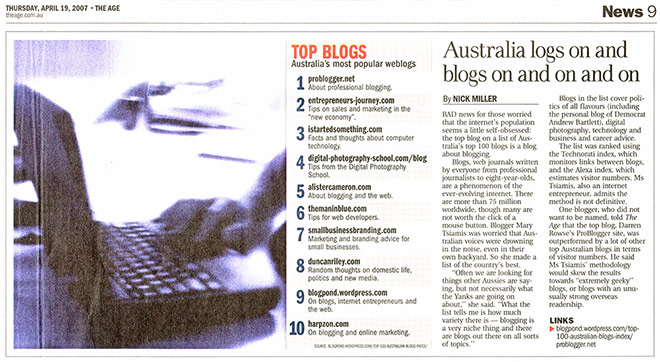
Fact: This blog is not about “facts and thoughts about computer technology”.
Thought: Do I get a trophy?
Interactive Office 2007 advertisement on MSN.com
 I can’t believe I’m saying this, but an advertisement on MSN.com just blew my mind. I think what Microsoft has done here can be regarded as revolutionary in the market of internet advertising and could spark a new wave of interactive ads on the internet.
I can’t believe I’m saying this, but an advertisement on MSN.com just blew my mind. I think what Microsoft has done here can be regarded as revolutionary in the market of internet advertising and could spark a new wave of interactive ads on the internet.
Let me show you what happens if you visit MSN.com today.
If you don’t have Quicktime or somehow didn’t understand the video, what you have here is the MSN website sitting inside a virtual Office Word document. The page is styled to look exactly like the Office Word 2007 interface, with everything from the Ribbon Fluent toolbar to the blue page background. Whilst most parts are not interactive, you get a pretty good sense of the interface. Suddenly, this whole page in essence becomes part of the ad, but that’s not the half of it.
The revolutionary part is how you interact with this ad that blows everything else out of the waters. The feature of Office 2007 this ad portrays is Live Preview – the ability to see style changes on documents before making a choice. What might seem like a simple idea is actually very hard to communicate and demonstrate. The only way to show how powerful such a feature is usually involves allowing the user to try such a feature. Why not let them experiment with something that’s in-front of them right now?
This ad does exactly that. With some fancy Flash scripting, you can actually modify certain parts of the MSN.com website as if you were editing a Word document.
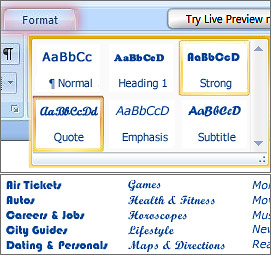
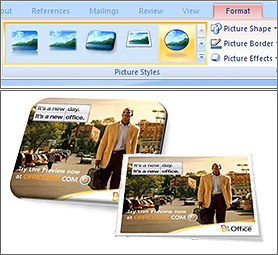
Changing font styles on MSN.com with Office 2007 interactive ad (left). Changing picture styles (right).
Here is what the MSN team had to say about this ad on their “Inside MSN” page.
What happened is that MSN is trying out a novel form of advertising.
During one 24-hour period, MSN embarks on its initial foray into an interactive ad experience that enables users to preview and manipulate the fonts and pictures on the MSN.com homepage just like products in the new Microsoft Office suite, such as Word and PowerPoint.
The goal is to make it more than just interesting or tolerable, but engaging.
This effort is tied to an April advertising campaign that provides Microsoft a twofold opportunity: promoting a major software upgrade; and allowing MSN’s advertising team a new level of creativity, complexity and interactivity with an in-the-family advertiser.
At the brainstorming stage, the digital advertising group that focuses on branded entertainment and experiences landed on this idea: What if MSN was inside Microsoft Office Word for the day?
I really think Microsoft hit the nail on the head with this. It’s creative, smart and engaging. They’ve given the right amount of control to users, just enough to have fun, but not enough to wreck havok. Allowing users to even opt-out of the experience is admirable. Recognizing the problems with traditional advertising, trying to do something about it and taking risks experimenting is an effort well worth applauding.
“Go” – The music from Silverlight & Longhorn videos
With the help of Sean Alexander, who happens to be the Microsoft director responsible for Silverlight and producing the showreel video as well as a good friend, has informed me the music from the Silverlight promo video is a remix of the track by Andy Hunter called “Go”. Most notably, this song was also used in one of the Longhorn promotional PDC 2003 videos.
Andy Hunter appears to have quite a relationship with Microsoft, performing at many Microsoft events including the launch of XP Media Center 2005. There is a streaming video of that event with Andy playing this song, “Go”.
You can hear a 30-second preview of the song on his album page. The song is available from Amazon, iTunes and Allofmp3 as well as many other favorable distribution sources.
Windows DreamScene to support 3D rendering?
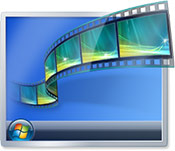 Before the launch of Windows Vista, I had a lot of high hopes for Desktop Aurora, a rumor floating around the concept of animated desktop wallpapers, including dynamically rendered scenes. When the Windows Ultimate Extra DreamScene was officially announced at CES in January, it provided both a sigh of relieve and disappointment to what many had hoped for. Whilst DreamScene is still a well-received feature by many, it didn’t bring anything revolutionary to the experience – video wallpapers has been available for quite some time (although DreamScene is technically superior quality-wise). But today, my hopes are restored.
Before the launch of Windows Vista, I had a lot of high hopes for Desktop Aurora, a rumor floating around the concept of animated desktop wallpapers, including dynamically rendered scenes. When the Windows Ultimate Extra DreamScene was officially announced at CES in January, it provided both a sigh of relieve and disappointment to what many had hoped for. Whilst DreamScene is still a well-received feature by many, it didn’t bring anything revolutionary to the experience – video wallpapers has been available for quite some time (although DreamScene is technically superior quality-wise). But today, my hopes are restored.
In an Australian trademark application filed last week for the word “DreamScene”, Microsoft provided an interesting classification to this product.
Class: 9 Operating system software; computer software for displaying video and three-dimensional images as background on a computer screen
I read it several times to make sure I was not misinterpreting. Three-dimensional images could have meant static images detailing 3D objects or videos showing 3D scenery, but that shouldn’t be the case since static wallpapers are just wallpapers and videos aren’t distinguished by dimensions. It could only mean one thing, live 3D-renderings.
Currently, DreamScene only supports high-definition video loops to create the experience of a seamlessly animated scenery. For 3D, you have to download Stardock’s free add-on, DeskScapes. Only DeskScapes add support for dynamic 3D renderings with its proprietary .Dream format.
Practical examples of 3D wallpapers they present include a rotating Earth showing the day/night cycle, and also a weather application that generates a scene based on the weather in your locality. If Microsoft does decide to add 3D support in DreamScene, it is unknown how that might affect Stardock.
Three-dimensional wallpapers as opposed to film loops on the desktop might actually become practical than just quick-melting eye-candy. Microsoft knows the techniques to present information (such as weather, time) at a sub-conscious level on the desktop, they have a patent for it. I think it is about time to use that patent to deliver something truly revolutionary.
Update: I have been told DreamScene will not support live 3D renderings at its release.
Win a copy of Lego Star Wars 2 (PC)
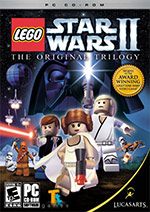 Back in January at CES, I got a copy of Lego Star Wars 2 inside the Vista press kit provided by Microsoft. I’ve played it and even if you have no interest for Star Wars or Legos, this is an extremely fun game – perfect to entertain children with. It also sets new benchmarks for co-op gameplay, something that I’ve missed in games for a long time.
Back in January at CES, I got a copy of Lego Star Wars 2 inside the Vista press kit provided by Microsoft. I’ve played it and even if you have no interest for Star Wars or Legos, this is an extremely fun game – perfect to entertain children with. It also sets new benchmarks for co-op gameplay, something that I’ve missed in games for a long time.
Since I no longer need this, and instead of selling freebies (shame), I thought it would be good idea to share something I got for free and enjoyed for someone else to enjoy too.
The winner will receive one used copy of Lego Star Wars II: The Original Trilogy PC-CD still with that fresh plastic scent on the inside. Can’t say much about the outside except I’ve touched it many times with fingers of varying quantities of oil. The disc is in very good condition with only slight wear and tear. This game needs no CD-key so can be easily transferred, but does use SecuROM anti-copying technology developed by Satan himself.
 To win, write an essay (at least 600 words) about how cool Long is and how he will one day be rich and famous. Just kidding. Simply write a comment (with your email) speculating what Microsoft will announce at MIX07 in 2 weeks. Employees of Microsoft are advised to enter.
To win, write an essay (at least 600 words) about how cool Long is and how he will one day be rich and famous. Just kidding. Simply write a comment (with your email) speculating what Microsoft will announce at MIX07 in 2 weeks. Employees of Microsoft are advised to enter.
A winner will be drawn at random sometime this week. Postage paid, will post internationally. Contest open to all ages above pi. This contest does not discriminate and invites all Canadian users to participate too, however no Chinese spam entries please. Communism and freebies do not mix.
Update: Whoops. Forgot to select a winner last week. Better late than never. With the help of Josh Phillips, the winner randomly selected is Daniel. If you didn’t win, crying is recommended.
Chris Aarons leaves AMD
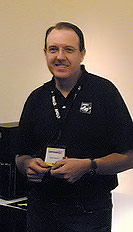 There’s a lot of people moving around lately, especially to do their own little thing after working at a big successful corporation. An obvious example is with Hillel Cooperman, Walter Smith and Jenny Lam from Jackson Fish. The latest of these migrations is Chris Aarons, the friendly PR guy from AMD.
There’s a lot of people moving around lately, especially to do their own little thing after working at a big successful corporation. An obvious example is with Hillel Cooperman, Walter Smith and Jenny Lam from Jackson Fish. The latest of these migrations is Chris Aarons, the friendly PR guy from AMD.
You might think you’ve never heard of Chris, but he helped put together the Vanishing Point puzzle, send out complimentary bags for CES, and provided many opportunities for bloggers to try out the latest technologies from AMD. It takes someone to send out a bag, but it takes something more to send your business card to complete strangers.
I didn’t know Chris very well, and it hurts me to say I’ve probably caused him the most trouble during his career at AMD. Some of you might remember that little misunderstanding of generosity at December of last year, if you don’t, please don’t look it up. I cannot imagine how much trouble that incident might have caused Chris, but I sure didn’t expect him to ever interact with me again. But Chris did. Not only is Chris interacting with me, he’s even helping me. You see, I never got a computer, it’s a long story. I have a lot to thank Chris for.
Of course, I’m not the only one with a positive experience with Chris. Michael from HardwareGeeks.com where I learned of the story originally also expressed his thankfulness to Chris, and so did Andru from GearLive.
I wish Chris the best of luck with his new venture, Buzz Corps Inc. If any company needs a public relations expert who knows how to connect with bloggers, don’t go past Chris Aarons.